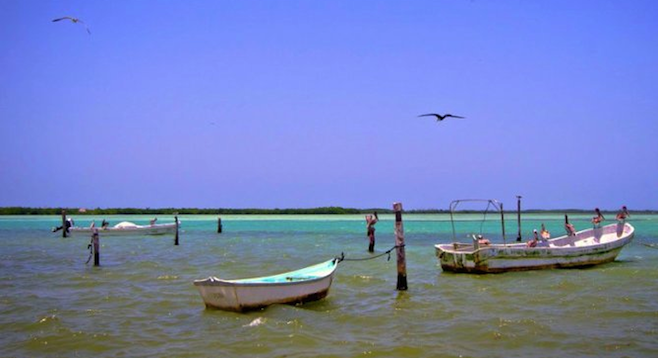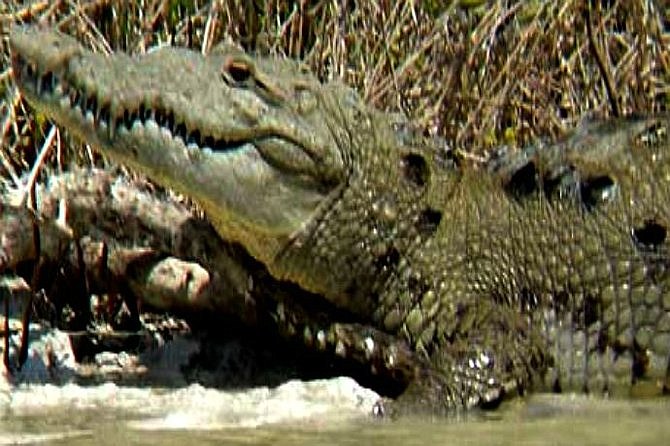 Facebook
Facebook
 X
X
 Instagram
Instagram
 TikTok
TikTok
 Youtube
Youtube

When you're in Cancun – and are tired of white sand beaches and turquoise water – drive to Río Lagartos, where you have a chance to see bright pink flamingos, sea turtles, rare birds and crocodiles at night. You’ll pass the small colonial towns of Tizimín and Porto San Felipe on the easy two-hour drive.

Río Lagartos is part of a designated biosphere reserve and has the largest population of American flamingos in Mexico; the coastal lagoon areas contain 388 different bird species (we saw over 100). On the beaches you might see white marine turtles nesting (left), horseshoe crabs, and possibly raccoons in the mangroves.
After our day of sightseeing, we went to the local mud flats where we experienced a Mayan mud bath.
Río Lagartos Adventures, an eco-tourist cooperative of local naturalist guides, is led by Diego Nuñez and offers fish, flamingo tours and birdwatching on land and boat and crocodile night tours as well as boats, mountain bikes and kayaks. When you enter Río Largartos, continue on Calle 10 and when you arrive at the malecón continue to the only lighthouse in the area. You'll find them at La Torreja, the only palapa restaurant where you can feast on fresh Mexican seafood. (You can also book on their website.)
If you prefer birdwatching from the comfort of your chair or hotel, stay a night or two at the friendly Hotel Villa de Pescadores, where you can sit on your balcony and watch aquatic birds with a view of the entire bay and lighthouse.
For those more adventurous, take the road from Río Lagartos to Las Coloradas at kilometer 8 and 9 to find a small sign to the entrance of a hiking path called Sendero Peten Tucha. This place is part of the unspoiled Yucatan ignored by most tourists. There's a freshwater spring with elevated boardwalk through the wetlands.

At the end of the trail, climb a tall observation tower for a spectacular wetlands view. You might see crocodiles, turtles, tropical birds or monkeys. There's a sign warning "No nadar – cuidado – cocodrilos" (Do not swim – caution – crocodiles).
You can also take a three-hour Noreste bus from Cancun for approx. $12.00 one way. The best time to see birds is the early morning, and the best months to see wildlife are June to August.
Visiting Caribbean Mexico? See Reader Travel's "Ancient World" stories on Chichen Itza (2 hrs west of Cancun), Tulum (2 hrs south), Coba (2.5 hrs).


When you're in Cancun – and are tired of white sand beaches and turquoise water – drive to Río Lagartos, where you have a chance to see bright pink flamingos, sea turtles, rare birds and crocodiles at night. You’ll pass the small colonial towns of Tizimín and Porto San Felipe on the easy two-hour drive.

Río Lagartos is part of a designated biosphere reserve and has the largest population of American flamingos in Mexico; the coastal lagoon areas contain 388 different bird species (we saw over 100). On the beaches you might see white marine turtles nesting (left), horseshoe crabs, and possibly raccoons in the mangroves.
After our day of sightseeing, we went to the local mud flats where we experienced a Mayan mud bath.
Río Lagartos Adventures, an eco-tourist cooperative of local naturalist guides, is led by Diego Nuñez and offers fish, flamingo tours and birdwatching on land and boat and crocodile night tours as well as boats, mountain bikes and kayaks. When you enter Río Largartos, continue on Calle 10 and when you arrive at the malecón continue to the only lighthouse in the area. You'll find them at La Torreja, the only palapa restaurant where you can feast on fresh Mexican seafood. (You can also book on their website.)
If you prefer birdwatching from the comfort of your chair or hotel, stay a night or two at the friendly Hotel Villa de Pescadores, where you can sit on your balcony and watch aquatic birds with a view of the entire bay and lighthouse.
For those more adventurous, take the road from Río Lagartos to Las Coloradas at kilometer 8 and 9 to find a small sign to the entrance of a hiking path called Sendero Peten Tucha. This place is part of the unspoiled Yucatan ignored by most tourists. There's a freshwater spring with elevated boardwalk through the wetlands.

At the end of the trail, climb a tall observation tower for a spectacular wetlands view. You might see crocodiles, turtles, tropical birds or monkeys. There's a sign warning "No nadar – cuidado – cocodrilos" (Do not swim – caution – crocodiles).
You can also take a three-hour Noreste bus from Cancun for approx. $12.00 one way. The best time to see birds is the early morning, and the best months to see wildlife are June to August.
Visiting Caribbean Mexico? See Reader Travel's "Ancient World" stories on Chichen Itza (2 hrs west of Cancun), Tulum (2 hrs south), Coba (2.5 hrs).
Comments